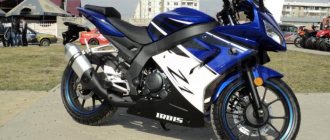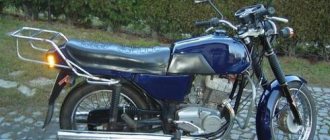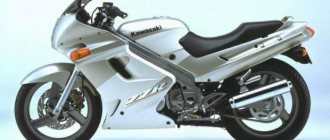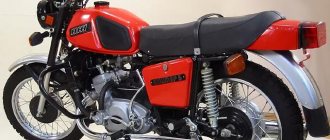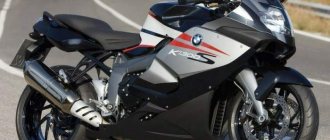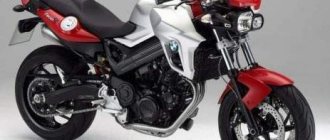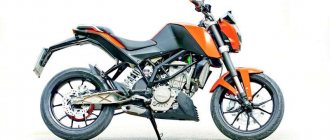Beginners often ask questions: “How not to make a mistake and not waste money? What should you pay attention to when purchasing? – answers in the article.
Cross-country motorcycles are designed for motocross - a sport that involves racing with obstacles (for example: hills, ravines, jumps) over rough terrain.
Sports motorcycles, the so-called “kings of off-road”, are not made for asphalt. Their design does not imply the presence of elements such as lighting equipment or an electric starter on closed tracks.
A cross-country motorcycle has a low weight (on average 80-120 kg) and a long-travel suspension. As a rule, it has a powerful motor, but the engine’s potential is realized mainly at maximum speed. Such motorcycles do not require registration with the traffic police, as they are intended for off-road use, and do not require a driver’s license.
What is a motocross motorcycle?
To understand the difference between a motocross motorcycle and its counterparts, you need to understand the various types of motorsports. Motocross is a race on a closed track from 1.5 to 3 km long with various obstacles. To reach the finish line first, the racer needs to go as fast as possible, easily overcoming obstacles and jumping over uneven terrain.
A motocross motorcycle is the most lightweight type of equipment designed for competition. You can't drive such a motorcycle on an ordinary street, because it has:
- there are no headlights, turn signals, mirrors or license plates;
- not included in the battery design;
- electric starter replaced with kickstarter;
- Large spoked wheels with lugs are great for off-road driving;
- The suspension is made to last - rigid and strong.
What is the difference between an enduro and a motocross motorcycle?
Bike lovers note some similarities between enduro motorcycles and their cross-country models. Indeed, they are somewhat similar in appearance, but they have fundamental differences in design and scope:
- Cross-country racing motorcycles are used exclusively for participation in competitions; riding them on the streets is prohibited. Enduro was created for lovers of trails, as well as hunting and fishing.
- The enduro has a quiet engine, while the cross bike roars with all its power.
- The difference between an enduro and a motocross motorcycle is that it is equipped with lighting, mirrors and navigation devices, which will only make a sports bike heavier for off-road racing.
- Stiff and durable suspension and sophisticated cross-country brakes will give any enduro a head start.
- Enduro can be driven over long distances, it is subject to state registration and requires the driver to have a category “A” license. A sports bike doesn't need all this.
What is the difference between a pit bike and a motocross motorcycle?
Sometimes pit bikes are called evolved bicycles. Initially they were used for working maintenance of other motorcycles participating in racing. Nowadays, such bikes are used to teach children how to ride motorcycles. They are also suitable for beginners who want to learn some tricks on bikes. Based on the differences in the field of application, the design of a motocross bike and a pit bike is fundamentally different:
- A pit bike has smaller wheels, while a crossbike has larger ones.
- A sports bike is always equipped with a single-cylinder engine, its sibling has other options.
- The soft suspension of a pit bike, designed for long riding while sitting, is contrasted with the hard suspension of a sports bike.
- The exhaust sound, braking system and type of engine cooling also differ.
Appearance
The Honda CRF 450 has few distinctive design features. The red frame color combined with light gray is typical for many cross bikes of this brand. A little black. The standard fender shape and stance is due to the fact that this bike is intended for competition, where design variations are not encouraged.
Of course, if you look at the (amateur) modifications, it is sometimes possible to mistake a bike for another model. At least if you look at the photo. However, a person well versed in the dynamics of cross-country equipment is unlikely to confuse this motorcycle with something else in action (if judging by the video from the competition).
How to choose a motocross motorcycle?
Professional athletes and motocross beginners approach the purchase of an iron partner with full responsibility. The choice of a motocross motorcycle is based on several fundamental characteristics:
- Manufacturer
. Sport involves serious health risks, so saving on the cost of the bike is not worth it. It is better to trust world-famous motorcycle manufacturers - Yamaha, Kawasaki, Suzuki, Honda, KTM. - Technology class
. Not only professional athletes, but also children and young men can take part in the competition. Special bikes are produced for each category. - Engine power and displacement
. This parameter is directly related to the previous one. For children, engines with a volume of up to 50 cm3 are chosen; for an adult beginner, 125 cm3 is suitable. - Engine's type
. Two-stroke engines are simpler, more powerful, have good torque and are cheaper, inferior to four-stroke engines in reliability and service life.
photo2
Cross motorcycle with sidecar
A separate type of competition is racing on motorcycles with sidecars. Such a racing motorcycle is no different in design from a regular one, except that a sidecar for a second athlete is attached to it. The second rider is actively participating in the competition. Its main task is to prevent the motorcycle from tipping over, stabilizing it with its weight. It must move quickly and accurately towards the center of rotation.
Children's motocross motorcycle
The age of athletes participating in motocross is significantly reduced. Today, according to the rules of the competition, children over six years of age can take part in them. The next age group is 9-13 years old. Naturally, a motocross motorcycle for children differs in both its size and technical characteristics. Their appearance is similar to adult sports bikes.
The best motocross motorcycle for a child, according to reviews from coaches and young riders themselves, is a model from KTM. The company specializes in producing units for different age groups, differing in size, engine size and clutch type. The simplest models, designed for learning the basics of driving, are equipped with an automatic clutch; more advanced models have a full six-speed gearbox.
Rating of motocross motorcycles
Professionals and amateurs have long compiled their ratings of reliable and high-quality models, the most popular of which are:
- Honda CRF250
– the choice of motocross beginners. A novice athlete will be able to train comfortably on such a bike. - Suzuki RM-Z250
– the most powerful cross-country motorcycle in its class, which also has ideal handling. - Kawasaki KX250F
– the model has several engine variations. - Yamaha YZ250F
– a good model that is suitable for both beginners and experienced athletes. - KTM 250SXF
– a fast and reliable motorcycle at a very reasonable price.
Which motorcycle should you choose first? 15 models for beginners
In urban conditions, a motorcycle provides an undeniable advantage in maneuverability and speed of movement, which is why the number of owners of two-wheeled vehicles is growing rapidly from year to year. More and more “first-season riders” are appearing in the ranks of motorcycle enthusiasts, many of whom are asking the age-old question “which motorcycle should I buy first?” We tried to summarize all the parting words from “experienced” people regarding the purchase of their first motorcycle in one huge review.
Of course, it is not possible to combine all the options (especially among used motorcycles), so we limited ourselves to the models published in the catalog and tried to offer a generalized selection of new motorcycles for a wide variety of budgets and tasks. All models listed in the review can be purchased in the showrooms of official dealers in stock or on order. Well, we will tell you which used models to choose as your first motorcycle in the next issues of the magazine.
Purpose of the motorcycle
First, you need to decide why you are buying a motorcycle. Where do you plan to travel with it most often? Let’s say, moving around Moscow every day will be more convenient on a small-capacity scooter than on a shiny, lame cruiser, because image, especially in 30-degree heat, is nothing in this case. For driving mainly on paved intercity roads, it makes sense to pay attention to the bonneted (plastic-lined) versions of motorcycles, and for bad roads it is better to choose a motorcycle with a long-travel suspension - it will better cope with uneven surfaces at the entrance to your summer cottage.
You need to choose a motorcycle with your heart, but in your choice it is also recommended to proceed from the physical characteristics of the owner. Being a two-meter athlete, you should not consider purchasing equipment that is too small and vice versa - it is important not to overestimate your capabilities by choosing an overly powerful or heavy device.
Expensive equipment and an abundance of electronic systems do not guarantee the safety of a beginner who chooses a sportbike as his first motorcycle.
The lighter the motorcycle, the easier it is to control it at low, and therefore suitable for learning, speeds. In the future, most of these nuances will be leveled out by experience, but in this case we are talking about buying a first motorcycle for 1-2 seasons.
Motorcycle classes
Motorcycles can be divided into several classes, depending on their design, appearance and intended purpose. Here are the main ones:
Road
The easiest place to start is with classic road bikes. On most “road bikes” you are provided with the correct seating position and easy adaptation to motorcycle controls. Often, road motorcycles have a plastic fairing and sometimes look like the so-called. “sportbikes”, although, of course, they are not such.
Road motorcycles are comfortable for city and highway riding and are sometimes called "all-rounders". Modern models are usually equipped with an anti-lock braking system (ABS) and sometimes with a stability control system (TCS). These “electronic assistants” are designed to make it easier to control the bike and prevent such dangerous situations as wheel locking during emergency braking, or, on the contrary, slipping of the rear tire during acceleration (“drift”). However, such systems are often installed on motorcycles of other classes.
Cruisers
Motorcycles of the Cruiser class are often mistakenly called “choppers,” but unlike the classic chopper with an extended fork and a rigid “hardtail” rear suspension, cruisers are quite suitable for daily use. These “limousines” are designed for leisurely movement on good quality roads and suburban highways. However, there are also “wolves in sheep’s clothing”: uncompromising power cruisers, whose acceleration and handling are reminiscent of sportbikes (though such “steroid jocks” are prohibitively expensive to match their characteristics).
Cruisers, due to their too loose fit and low maneuverability, are not the best choice as a first motorcycle; in addition, some of them are quite heavy and wide for moving along narrow city aisles. But sometimes these bikes are so consistent with the style and charisma of the owner that there are no other options left except buying a cruiser.
Scooters
The scooter is an excellent vehicle for city riding due to its small dimensions, the presence of a luggage rack under the saddle and minimal fuel consumption. There is no need to operate a gearbox on a scooter, since most models have a CVT.
The engine capacity of modern “mopeds” ranges from 50 cm3 to... 800 cm3 for new models. In addition, ABS is very common among new bikes. But the popularity of scooters as the first two-wheeled vehicle has decreased somewhat, since a driver’s license has been required to drive even the simplest fifty-kopeck scooters since 2013.
All-terrain
An all-terrain motorcycle will give you that feeling of freedom that experienced motorcyclists talk about. You no longer need to think about the quality of the road surface or its availability in general - the long-travel suspension will easily cope with all the bumps on your way.
You will have to pay for cross-country ability with lower cruising speed on the highway, a modest gas tank and high windage. We will only talk about dual-use models - uncompromising “enduro” and “evil” motocross motorcycles are not suitable for the first season at all, except in cases where a beginner aims to use the equipment exclusively in closed areas and is ready to transport the motorcycle to the place of “rides” in a trailer.
Sports
Sports motorcycles are the right choice for track riding. But riding a “sportbike” around the city can become a deadly activity for a beginner: according to the sad statistics of motorcycle accidents, the majority of accidents occur among owners of “sports” who failed to control the “explosive” projectile. And every fall on a lightweight “plastic” motorcycle costs the would-be motorcycle racer a very substantial amount - a rare “sport” can be equipped with the safety bars that are so necessary for a beginner, because their installation often requires breaking the integrity of the fairing.
But the aesthetics and power of sports motorcycles are so attractive to novice bikers (and, to be honest, girls who love motorcycles), that we will consider several options suitable for an inexperienced motorcyclist in this class.
Tourist
Motorcycles of the tourist class can be divided into all-terrain, luxury and sport-tourism.
All-terrain tourists are distinguished by increased suspension travel, high ground clearance and good wind protection (however, their use on real off-road terrain is limited by their rather large weight). Luxury tourers combine passenger and driver comfort, luggage capacity and greater weight, which has a positive effect on stability when driving at high speeds in a straight line. The catalog of options on such bikes is usually comparable to a telephone directory, and the price is far beyond the average budget for a first motorcycle. Well, sports touring models are distinguished by a powerful engine, comfortable seating and an unattainably high price tag.
Based on a combination of factors, a touring motorcycle is not the best choice for a beginner, however, there are exceptions here too...
Options for motorcycles suitable for the first season.
The reality is that you can get on and ride on any motorcycle, absolutely any cubic capacity. However, it is important to understand that riding a powerful bike is associated with a high level of risk and it is worth starting your acquaintance with the world of motorcycles with “friendly” bikes. Such motorcycles will not present surprises when you suddenly open the gas and will be predictable in handling and deceleration.
We have selected several worthy options for the first season in each class of motorcycles and in different budget ranges - from 150 to 750 thousand rubles for a new unit from the showroom.
Please note that the photographs of motorcycles are prepared in real scale - you can evaluate the ratio of the dimensions of different models and even “try on” them to suit your height (on the motorcycle page).
Road
Honda CB125
Honda fans will not ignore the small-capacity CB125. This motorcycle is an excellent alternative to the memorable Yamaha YBR125 - at a lower price, the CB125 has a little more torque, has a more laconic design, and also has a built-in indicator of the selected gear, which is an extremely useful option for both beginners and experienced motorcyclists. Having larger dimensions than the YBR, the small-capacity Honda looks and feels less “bicycle-like,” which has a positive effect on the comfort of movement. Well, Yubra itself will be recommended to you by fellow motorcyclists as a universal answer to all occasions, which it was when it cost 75–90,000 rubles.
However, the YBR125 still remains the most accessible Yamaha model for a beginner, because... its closest twin, the Fazer250 (known on the foreign market as the YBR250) costs 255,000 rubles, apparently in the company’s desire to get rid of family ties with the inexpensive Ubers, including the price.
Bajaj Pulsar 200NS
In 2015, the Indian concern Bajaj literally burst into the Russian market with two new models - the “naked” Pulsar 200NS and its hooded version RS 200. For beginners, we recommend purchasing a version without plastic, because in the event of a fall, the minimum cladding on the “naked” version is practically not will suffer, which cannot be said about the version with a fairing.
Pulsar 200NS is a calm, friendly motorcycle with a modern fuel-injected engine and anti-lock braking system. The low saddle makes it possible for even short pilots to feel confident.
The cost of the Bajaj Pulsar 200NS in Russia starts from 179,000 rubles and is the most affordable “200” on the market.
For those who prefer proven brands to new ones, we can recommend the KTM Duke 250. The Austrian Duke is an excellent city lighter. For a very reasonable amount, you will get a light and maneuverable motorcycle that will not give you offense in the city crowd.
Equipment for motocross motorcycle
When deciding to take up motorsports, you should understand that you will have to spend money not only on a motorcycle, but also on protective equipment. Its main elements:
- A helmet
for a motocross motorcycle is an essential element of protection that should not be skimped on. Premium brands make lightweight helmets with better head and neck protection. In budget models, the weight is relatively large, which does not have the best effect on fatigue of the cervical spine. - Motor glasses
. If you have the funds, it is better to choose several models for different weather conditions. - Neck protection
, the so-called “collar”. - Shells
protect the body, which are selected individually not only according to the size of the rider, but also the riding style. - Protective pants or shorts
are useful during falls on hard ground. - Lumbar protection
with a special belt. - Knee pads or braces
protect the rider's knees. - Motorcycle boots
. - Gloves
.
Price
Saving by choosing low-quality equipment can be costly - at best, only the wallet will suffer (money will be required for restoration and repairs), at worst, the driver’s health.
In addition to the equipment itself, you need to pay attention to the cost of spare parts and protective equipment. Almost all parts in a motocross motorcycle are consumables; some elements need frequent replacement.
How to ride a motocross motorcycle?
Sports motorcycles require the rider to have theoretical knowledge of riding on difficult tracks and constant practice, without which the acquired skills are lost. Athletes begin training from the very basics, gradually moving on to learning tricks of varying complexity:
- The correct landing and stance are studied.
- Start and stop technique.
- Changing gears and actions during them.
- Slow down and drive in a straight line.
- Avoiding corners.
- Passing various sections of the route.
- Jumping.
Do you need a license for a motocross motorcycle?
Due to their design and performance, motocross racing motorcycles are prohibited for use outside of a dedicated race track. Driving them on the street will not bring pleasure to both the rider himself and everyone around him, so to own such a type of transport, an athlete will only need documents confirming ownership. Category “A” rights, as well as vehicle registration with government agencies, are not required.
The difference between an enduro and a motocross motorcycle
Many who are not yet into the subject of enduro or motocross initially do not see the difference between these types of motorcycles. Those who are still planning to buy a two-wheeler may also not know these basics. Remembering ourselves a little earlier, in the first year of enduro riding on the first 250s, we thought that the next motorcycle would be easier to buy a cross bike and forget about the lack of power. But such thoughts did not linger in our heads for long. Soon the differences between enduro and motocross bikes became so obvious to us that we were glad that we had not made a foolish decision by buying a motocross bike for enduro riding. In part, we can say that we have become truly successful, thanks to the fact that owners of motocross motorcycles still appeared in our company.
So, let's find out how these types of motorcycles differ. Indeed, for most people observing these motorcycles from the outside, the differences end in the absence of headlights and brake lights on a motocross bike. But it is important to know that the difference comes from the scope of application of these motorcycles. Therefore, let's imagine the conditions under which they are used. For motocross, this is most often a high-speed, looped track that is completely known to the rider, on which there are no obstacles, but there may be jumps of various types. On these jumps, riders have to fly high and, accordingly, land. The driving mode, as a rule, is sharp acceleration at full throttle and effective braking before turns. Of course, motocross is held during daylight hours, or in special rooms with artificial lighting.
Cross as an enduro is hard
For enduro, everything is not so simple, since more and more types of enduro motorcycles for different riding appear every year. But we will try to highlight the general aspects of operating a sports enduro, which clearly distinguish it from motocross motorcycles. We will describe the obvious differences between touring enduros separately. So, for enduro, most often it is an initially unknown or little-known long track with natural terrain and obstacles, on which it is sometimes necessary to both quickly accelerate and carefully overcome obstacles at low speed. Obstacles can be different: stones, logs, difficult terrain, mountains, a narrow bridge over a river, and so on.
Having this information, making a list of differences and understanding why it was done will not be difficult.
So, a motocross motorcycle is characterized by:
- Pendants designed for jumping. These suspensions are rigid and clamped, so that the motorcycle does not make unnecessary movements in a straight line, and also the most energy-intensive to absorb energy when landing after high flights. And these bikes are also as high as possible in the saddle. Riding on stock motocross suspensions over obstacles is a real punishment; they swallow bumps and obstacles very poorly, giving everything to the handlebars and saddle.
- High speed engines. The torque curve of motocross engines is such that they have very poor low end (compared to enduro). The goal of a motocross motorcycle is to accelerate as quickly as possible, so the engines always operate at high speeds, where they have the highest possible torque. These engines are difficult to drive at low speeds, and maximum power is developed far “up”. Quiet riding at medium speeds is not what a motocross motorcycle is about; it reacts very sharply to opening the gas, and is difficult to adapt to. This also results in high gas consumption.
- Short gears in the box. We remember that a motocross motorcycle must accelerate as quickly as possible. Due to the difficult terrain of the motocross track, maximum speeds do not exceed 100 kilometers per hour on average. Considering that the engine operates exclusively at high speeds, closely spaced gears are needed to accelerate the bike to 100 kilometers per hour as quickly as possible. That is why a motocross bike has the closest possible gears, and so much so that when you sit down for the first time after enduro, you may not even understand where you switched, maybe to 2nd, or 3rd, or 4th gear, it rides almost unchanged.
- Small gas tank. Gasoline should be enough for a few rides maximum, so you are unlikely to find a tank larger than 6-7 liters on a motocross motorcycle.
- Lack of electric starter (until approximately 2015). Due to the fact that excess weight is bad for motocross, and if the bike stalls, most likely you are lying around somewhere nearby, then an electric starter is something alien to these bikes. Therefore, motocross bikes were mainly equipped exclusively with a kickstarter, which allowed you to start the motorcycle with your foot. But technology does not stand still, engineers have learned to make lightweight electric starters and batteries, so new cross-country motorcycles are fully equipped with electric starters. It’s not hard to guess that kicking a kickstarter somewhere among the rocks or in a swamp is a dubious pleasure.
- Lack of headlights and lantern. There is no light, it is not needed. And without tuning, the generator of classic motocross bikes was not up to the task of power.
- Large fork stem. If you put an enduro and motocross bike side by side, you will notice that the cross bike's wheel moves forward. And this is so, since most often high speeds, this solution allows you to achieve stability, and maneuverability at low speeds in cross-country is absolutely not needed.
- Rear wheel 19 inches. Lower profile tires are much stiffer and more stable at high speeds.
- There is no footrest. An extra element, they don’t put it on to make it lighter; in motocross they use a special stand on which the motorcycle stands between races.
And sports enduro is characterized by:
- Softer suspensions that can absorb bumps, stones, logs and other obstacles. The important thing is that enduro suspensions allow you to adjust themselves, adjusting the bike to the conditions of the track. The bike can be tuned for slow riding in difficult conditions, or it can be tuned for serious jumps without any loss in performance.
- Engines with lower performance characteristics. Relevant for four-stroke motorcycles, since two-stroke motorcycles have their own character and 2t 250s cannot be called grassroots.
- A gearbox that allows you to drive comfortably in any speed range. Even though enduro bikes do not accelerate as furiously as motocross bikes, you can ride in 1st gear on a difficult section without any problems and comfortably and just as easily accelerate and maintain 100 kilometers per hour in a straight line.
- Large gas tank. Modern sports enduro motorcycles have a tank volume that allows you to ride the entire race without refueling, and unlike motocross, it most often lasts longer than 20 minutes.
- Headlight, lantern. The race can take place in the dark, light is needed. Most models are approved for public roads, where it is also impossible without light.
- Electric starter. Mandatory for all enduro sports.
- Fork angle for comfortable maneuvering at low speeds.
- Rear wheel 18 inches. On enduro motorcycles, the rear wheel has the same overall diameter as a motocross wheel. But the rim diameter is an inch smaller, allowing for higher profile tires. Due to this enduro, the rider can relieve the pressure in the rear wheel down to 0.3 atmospheres, and ride on the rubber in those places where the bike simply does not grip at high pressure, be it mud or sand.
HONDA CRF250
Let's start the review of this motocross motorcycle with the disadvantages, fortunately there are not many of them. Claims against the manufacturer are made on the following points:
- Poor handling at high speeds, a lot of weight on the front end, the damper doesn't really help.
- Double muffler, prone to damage and having increased weight.
- Poor and unreliable grip.
There are many more advantages:
- Excellent informative fork.
- Excellent ergonomic design.
- Powerful and confident front disc brake.
- Good entry into turns of any difficulty.
Motocross. What is a motocross motorcycle?
Cross-country motorcycles are, first of all, purely sports motorcycles. Their purpose is professional motorsport, competitions on special prepared tracks. A cross-country motorcycle requires maximum output from the engine with minimal weight and long-travel and energy-intensive suspensions to overcome high jumps.
The specificity of motocross is such that the motorcycle almost always rides at maximum speed and, accordingly, the engine is built in such a way that it realizes its full potential at the “top”. The design of the motorcycle is as lightweight as possible and is devoid of such unnecessary parts on closed tracks as lighting equipment and an electric starter.
The operation of cross-country vehicles on public roads is prohibited. Of course, even if you are not an athlete, you can buy a motocross motorcycle, but without sufficient experience and simply riding over rough terrain, you are unlikely to enjoy it as if you were doing it on the track under the guidance of an experienced trainer and participating in motocross competitions. A cross-country motorcycle will not make even an experienced motorcyclist bored, but it will simply exhaust a beginner with its sharp, even somewhat explosive character.
For a quiet ride “pull” on the roads, or slipping in the mud, enduro motorcycles are much more suitable, the engine of which has high torque at low and medium speeds.
HUSQVARNA FC250
This cross-country motorcycle is very similar in its characteristics to the previous model. There is a hydraulic clutch, a reliable front brake and an electric starter. Handling is better here, as the subframe absorbs a certain percentage of the stiffness from the rear shock absorber. This definitely improves ride comfort. The FC-250's ignition maps are switchable on the steering wheel in two positions. One mode is standard, the second position is designed for more aggressive driving.
Disadvantages are similar to the KTM: scattered powerband, stiff suspension unit, unwanted engine braking. It is better to make an additional hole in the ventilation duct, and do not forget to clean the air filter regularly. As a result, Husvarna is also aimed at professional racers or slow beginners who do not dare to shift above second gear. Nevertheless, reviews about the manufacturer are mostly positive, although among the listed disadvantages, consumers note a not very well-thought-out design.
Cross motorcycle – what and why?
Do you love speed and extreme sensations, but fast driving on city asphalt is not enough for you? Then a motocross motorcycle is your motorcycle! After all, it was not created for a smooth and level road. The energy of a cross-country bike (aka enduro) was born so that passing stones and clay, grass and sand, tree roots and stream beds are not an obstacle for him. On a cross-class motorcycle, you can ride along bumpy country roads and literally “jump over” small rivers. So, its main “element” is rough terrain. It’s not without reason that motorcycles of this particular class take part in famous desert rallies and take place in places where even a powerful SUV would stall. Of course, not everyone can take part in such a race, but if there is a sand quarry or a motorcycle track near the city, then go there and you will feel no less of an adrenaline rush from riding an off-road motorcycle.
And even if it’s winter outside and everything is covered with snow and ice, this does not mean that you need to put your “iron horse” in the garage. Vice versa! Winter is an opportunity to experience new winter sensations, since a cross-country bike behaves no worse on snow than on sand, and with studded tires, the riding season can last the whole year!
Let's give one more argument in favor of a motocross motorcycle. Since this class of motorcycle is not intended for riding on public roads, it does not need to be registered with the traffic police. It does not require a number like a regular motorcycle or car. You won't see headlights or turn signals on it either. And all because this is more of a sports equipment than a transport, and the designers are taking all measures to lighten the weight of the motorcycle. For those wishing to use a motorcycle in urban conditions, we recommend taking a closer look at universal motorcycles such as Irbis TTR250R, X-moto Raptor, Wels MX250 or Racer Enduro. These motorcycles are designed with turn signals, a license plate frame and the motorcycles are supplied with a title, which means you can register them and ride around the city with license plates. There are ravines and rough terrain that can’t escape you; all roads are open for supermotos!
So, if you are a fan of the impressions described above, and have firmly decided to buy a motocross motorcycle, let me give you some advice: The main thing is to decide: is the motorcycle used for many years, Japanese, or new - Chinese? There is a lottery here and there. The used racing bike market is littered with junk, and spare parts cost a lot of money. Whatever one may say, a serious argument.
If you look at the cross-country motorcycle from China, it’s a different story. Motorcycles are new, their price is not high, but during operation, increased attention and timely maintenance are required. Taking into account, again, cheap spare parts, the majority of the population is inclined to motocross and enduro bikes made in China. What could be better than a new motorcycle! Moreover, the new motorcycle market offers cubic capacity of 110 cm3, 150 cm3, 200 cm3, and 250 cm3.
What do the owners say?
They note that there are no particular differences relative to their rivals in the class. Not everyone likes the fact that there is a five-speed gearbox, believing that bikes with a six-speed gearbox are more convenient. Also, some would like to see an injector and a hydraulic clutch on the bike. Some would prefer better brakes, such as Bremb brakes.
According to the description of those who have owned the bike for a long time, the attachments here are not bad, but there are better ones in the class. But it, of course, is more expensive in itself, which makes the motorcycle as a whole more expensive. But the affordable price is the reason why many praise this model. About 150 thousand Russian rubles - that’s how much such a car costs on the secondary market.
IMPORTANT! Judging by the reviews, the resource has been here for about two to four years. That is, from 150 to 250 operating hours. That's how much the piston will last. Don’t think that this is a minus of this particular bike. Today this is, in principle, a common phenomenon, and it is worth keeping this in mind even when buying a new motorcycle, not to mention a used one.
Inexperienced bikers note that for that kind of money it would be possible to make a more comfortable and productive bike. In fact, the cost is explained by the fact that this is a serious, modern machine suitable for competitions, and not a training motocross bike for beginners. So the price-quality ratio is justified here.
The CRF 450 is a powerful off-road machine, or more precisely, a motocross machine. This is a bright representative of the class, which, however, sooner or later will get lost against the background of ever newer models. But even then, there will probably be people who want to buy a motorcycle on the secondary market.
Content
The combination of cross-country motorcycle riding and speed was the impetus for the emergence of motocross competition. One of the first cross-country competitions open to the public was the so-called "fox race", held at a military training ground near London in 1908. It involved 13 motorcyclists and 16 horse riders. The goal of the motorcyclists was to prove that the new off-road technology was faster than horses. However, it was the cavalrymen who won the race, and only two of the motorcyclists finished the competition [3] [4].
In subsequent years, motocross events continued to be held in the UK and France, but they did not arouse public interest - there was a lack of visibility. For the first cross-country races, one of the elements of the multi-day race was used - hill climbing. The start was single, not mass, the route was chosen so that not a single rider could reach the top, and the winner was the one who could cover the greatest distance [4]. It was only after the First World War that the most successful form of motocross racing was found in European countries. They began to be carried out on natural terrain with grassy, sandy or even mud (but without stones) surface, using a mass start.
Disputes about the length of one lap of the distance ended in favor of fairly short tracks - 1.5-3 km - as more spectacular for spectators and safer for the racers themselves. However, in the USSR and the USA, motocross races were organized with a circle length of 30 km or more [5]. This was due to the massive nature of motocross competitions - there were so many riders taking part in the race that they could not fit on the track without interfering with each other [4].
The official recognition of motocross in the USSR is considered to be the first All-Union Workers' Spartakiad, held in 1928. Her program included a 100 km motocross race. In 1936, the USSR motorsport championship took place in Kyiv. In 1957, motocross was held for the first time in Rastorguevo on a short track of 1.3 km in three races of ten laps [6].
Cross motorcycles
The first motocross competitions were attended by riders on road motorcycles, adapted to travel over rough terrain under their own power. Motorcycles were made lighter by removing parts unnecessary for competition - headlights, brake lights, trunk, passenger footrests, mirrors, the suspension was modified, and engine power was increased [7].
The advent of serial motocross motorcycles led to evolutionary changes in design. The original very wide handlebars, designed to increase leverage, have been reduced, and the travel of the fork and swingarm has been increased. The exhaust pipes located below began to be raised to prevent damage from falls [7].
Lightening the engine and simultaneously increasing its power led to the fact that the fairly common but heavy 4-stroke engines were replaced by light, high-revving, easy-to-manufacture 2-stroke engines. The engines became exclusively single-cylinder. The advent of cross-country tires made it possible to radically improve the handling of a motorcycle [7]. The electric starter was replaced with a kickstarter, and the battery was eliminated.
In the 1980s, these innovations marked the beginning of the modern motocross motorcycle design [7]:
- the seat
now seemed to float over the tank, which made the rider’s movements on the motorcycle more comfortable; - The heavy and ineffective drum brake was replaced by the disc brake
, which completely replaced the old system by the mid-90s; - the most important changes affected the suspension - a progressive suspension with a monoshock absorber
made it possible to increase the pendulum stroke, reduce weight and, although it was somewhat more complicated, still made the shock absorber work adequately in all modes; - Another significant change in the 80s was the advent of water cooling
, which replaced air cooling.
Further innovations were also associated with a reduction in sprung masses and led to the appearance of an inverted front fork, which made it possible to greatly improve the performance of the front suspension at modern speeds. The advent of new alloys and materials has made it possible to introduce new changes that improve the ride quality and power of motorcycles. In the late 90s, due to tightening environmental standards, 4-stroke engines reappeared on the market - the latest developments have made such engines quite light and reliable [7].
Thus, modern serial motocross motorcycles have long suspension travel - 300 mm or more, a powerful engine and a lightweight frame [8]. According to the type of engine operating process, they can be two-stroke (2T) or four-stroke (4T) [9]. They do not have lighting equipment, mirrors, dashboard, or side support. Most often they do not have an electric starter.
However, for example, in 2011, the electric starter was returned to the KTM motocross line of motorcycles [10].
Cross-country motorcycles are not registered with the traffic police, since they are not certified for travel on public roads and cannot have a title or license plate. A driver's license is not required to drive a motocross motorcycle, as it is a sports equipment.
Dimensions and weight
The dimensions are typical for the class: light weight, high ground clearance, small gas tank volume... It is worth noting the high seat height. People of short stature are unlikely to be suitable for this or other representatives of this class, which are distinguished by a significant value of this indicator. If the seat height were lower, this would inevitably lead to a deterioration in ride quality.
Dimensions:
- tank – 6.3 l;
- ground clearance - 328 mm;
- curb weight – 110 kg;
- height – 1274 mm;
- width – 827 mm;
- length – 2183 mm;
- seat height – 960 mm.
The dimensions and weight make this bike suitable for competition. The filling parameters also meet the standards. However, we cannot say that the design of this motorcycle is the best possible. This is not the limit of engineering development in this class.

